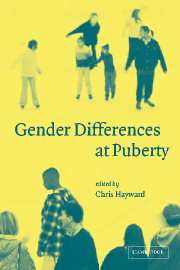Book contents
- Frontmatter
- Contents
- List of figures
- List of tables
- List of contributors
- Preface
- Acknowledgments
- 1 Methodological concerns in puberty-related research
- Part 1 Sex differences in hormones and their effect at puberty
- Part 2 Girls at puberty
- 4 Puberty and body image
- 5 Gender differences in opposite sex relationships: interactions with puberty
- 6 Aggression, psychopathology, and delinquency: influences of gender and maturation – where did all the good girls go?
- Part 3 Boys at puberty
- Part 4 Puberty and psychopathology
- Part 5 Pubertal timing: antecedents
- Part 6 Pubertal timing: consequences
- Part 7 Puberty and context
- Index
- References
4 - Puberty and body image
Published online by Cambridge University Press: 22 September 2009
- Frontmatter
- Contents
- List of figures
- List of tables
- List of contributors
- Preface
- Acknowledgments
- 1 Methodological concerns in puberty-related research
- Part 1 Sex differences in hormones and their effect at puberty
- Part 2 Girls at puberty
- 4 Puberty and body image
- 5 Gender differences in opposite sex relationships: interactions with puberty
- 6 Aggression, psychopathology, and delinquency: influences of gender and maturation – where did all the good girls go?
- Part 3 Boys at puberty
- Part 4 Puberty and psychopathology
- Part 5 Pubertal timing: antecedents
- Part 6 Pubertal timing: consequences
- Part 7 Puberty and context
- Index
- References
Summary
Puberty represents a period of dramatic physiological change that is unparalleled in development (Connolly, Paikoff, and Buchanan, 1996). Not surprisingly, this maturational process has a profound impact on the psychological functioning of youth. One of the most intense changes to occur at puberty involves body image, which refers to cognitive and emotional perceptions of one's body. The changes in body image are particularly striking because they involve marked gender differences. Body dissatisfaction is the most widely studied aspect of body image disturbances, which afflict a large segment of the population and appear to have adverse sequela including eating pathology, anxiety, depression, low self-esteem, and unnecessary cosmetic surgery (Thompson, et al., 1999). The aim of this chapter is to discuss (1) gender differences in body image perception in response to puberty, (2) the impact of sociocultural influences on this process, (3) the effects of changes in body image on broader psychological development, and (4) the limitations of the literature on this topic.
Pubertal status versus timing
It is important to differentiate the effects of pubertal status from the effects of pubertal timing (Graber, Petersen, and Brooks-Gunn, 1996; see also chapter 1). Pubertal status refers to the level of pubertal development at a certain point in time, whereas pubertal timing refers to whether an individual's pubertal development occurs earlier, later, or at about the same time as most adolescents. There are several important implications for this distinction.
- Type
- Chapter
- Information
- Gender Differences at Puberty , pp. 61 - 76Publisher: Cambridge University PressPrint publication year: 2003
References
- 23
- Cited by

